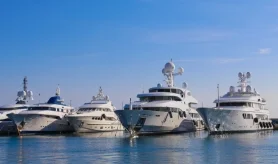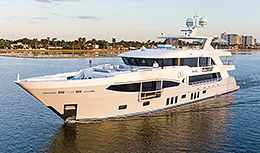- Alaskan Yachts
- Azimut Yachts
- Back Cove Yachts
- Beneteau Yachts
- Benetti Superyachts
- Bertram Yachts
- Boston Whaler
- Broward Yachts
- Buddy Davis Sportfish
- Burger Yachts
- Cabo Yachts
- Catamarans
- Carver Motoryachts
- Center Console
- Chris-Craft Yachts
- Cruisers Yachts
- DeFever Trawlers
- Dufour Sailboats
- Fairline Yachts
- Feadship Yachts
- Ferretti Yachts
- Formula Yachts
- Fountaine Pajot Cats
- Grady-White
- Grand Banks Trawlers
- Hargrave Yachts
- Hatteras Yachts
- Hinckley Picnic Boats
- Horizon Yachts
- Hydra-Sports
- Intrepid Boats
- Jarrett Bay Sportfish
- Jeanneau Yachts
- Kadey-Krogen Trawlers
- Lazzara Yachts
- Lekker Boats
- Luhrs Sportfish
- Marlow Yachts
- Maritimo Yachts
- Marquis Yachts
- McKinna Motoryachts
- Meridian Yachts
- Midnight Express
- MJM Yachts
- Mochi Craft
- Neptunus Motoryachts
- Nordhavn Trawlers
- Nordic Tugs
- Numarine Yachts
- Ocean Alexander Yachts
- Offshore Yachts
- Outer Reef
- Oyster Sailing Yachts
- Pacific Mariner Yachts
- Palmer Johnson Yachts
Frank Gehry’s First-Ever Yacht Design is One of a Kind
October 7, 2015 8:03 am
Last July, at the end of a Friday afternoon, Frank Gehry landed at Barnstable Municipal Airport, on Cape Cod, accompanied by his son Alejandro and his friend Bobby Shriver. The group drove straight to the Kennedy compound in Hyannis Port, and there the architect first saw her, anchored a little offshore.
A crowd had gathered, since, as Gehry says, “Hyannis Port is a real sailing community,” and because Foggy, whose name (based on an acronym for Frank Owen Gehry) had been etched in Gehry’s sloping scrawl onto its stern, is a sloop like no other. Fashioned out of traditional larch wood but accented with titanium and a glass latticework that glimmers like a school of fish, she looked schizophrenic, a hybrid of past and future.
Gehry boarded an inflatable tender (it had red seats that matched Foggy’s towering 105-foot mast) and headed out, accompanied by a swarm of Kennedys and Shrivers. “I felt very proud,” he would say later. Almost 87 years old (2/08/29, the date of his birth, is the number on the boat’s sails), he had, in a sense, spent his entire life getting here.
Gehry is an avid yachtsman, and sailing informs much of his most famous work—think of the billowing motif of the Guggenheim Museum Bilbao, New York’s IAC building, and, most recently, the Louis Vuitton Foundation in Paris. Yet only recently did he undertake his first sailboat design.
“I never had the resources before, and once I did I was busy doing my buildings,” he says. However, in 2008, Gehry found himself mulling the idea of designing a boat. He owns a fiberglass-hulled Beneteau First 44.7 (about to be renamed Foggy 1), which he keeps in Marina del Rey, California, and sails on Sunday afternoons, often with the architect Greg Lynn. The wives of both men tend to stay on land. (Lynn even had a boat called Girlfriend.) What if, Gehry wondered, he could design a boat that was both a signature piece and an enticement to his wife Berta?
He mentioned the idea to the developer Richard Cohen. A yachtsman too, Cohen had been wanting to build a large racing boat. After agreeing to work together, the two old friends brought in Germán Frers, an Argentine naval architect known for designing some of the most elegant fast sailboats in the world.
“Don’t let me go too crazy,” Gehry told Frers. “The boat has to work.” As instructed, Frers pushed back on Gehry’s plan for the vessel to have a flat, cabinless deck, which led to the choice of a curved “crown.”
However, when it came to choosing the material for the hull lining, Gehry and Frers drifted apart. Ever concerned with speed, Frers had proposed carbon fiber, the light, brittle material commonly used for racing boats. But Gehry wanted to line the boat with wood, partly because of “boat lore,” partly because he simply loves wood. Frers got a sinking feeling when he heard this, since wood adds weight without function. “I almost gave up hope the project would get done,” he says.
But in 2012, Cohen (who, full disclosure, is my significant other) found a possible compromise: build not just part of the boat with wood but the whole thing. He contacted the Brooklin Boat Yard in Maine, a small operation renowned for its carpentry as well as its engineering. One of its specialties is “cold molding,” a modern process that involves sandwiching wood around a high-tech core and yields lighter, stronger, and more durable craft than traditional planking.
Steve White, 61, the boatyard’s second-generation owner (and a grandson of E.B. White), was excited to work with Frers, but to have a non-boatbuilding architect of Gehry’s stature involved was daunting. And then he received Gehry’s drawings for the lattice windows on the deck and the stern.
“Bizarre,” was his reaction. In addition to its liberal use of materials like titanium, which few boat engineers have experience with, “there was a story behind every item on the boat—every cleat, doorknob, and showerhead.” And there were concerns that some of the unconventional elements could do more than just slow the yacht down.
“Glass steals a lot of the hull’s strength,” White says, likening Foggy’s windows to “holes in a pipe.” To see if they could withstand wave pressure, he and his team took sample panels to the technology laboratory at the University of Maine in Orono, where they hydraulically flushed the portals until they broke. (The windows turned out to be safe.)
Gehry, aided by his son Sam and a 3-D printer, “had fun” playing with Foggy’s design once he had found, or rather written, the boat’s “language.” “On a boat like this, it’s about romance and romantic encounters,” the architect says. At the heart of that fantasy is the yacht’s saloon, whose soft furnishings include a psychedelically colorful carpet created by Joyce Shin, Gehry’s daughter-in-law. It also includes sheepskin coverings for the couches from New Zealand, which turned the space into something between an Austin Powers–style lair and a discotheque.
Bizarre indeed. And yet, after joining Gehry in Hyannis Port and going aboard the sloop, Frers, and later White, had the same reaction. “It works,” both men said with considerable relief.
It also worked the following weekend, when Cohen and a crew tested Foggy in competition. Stripped of binnacles, bowsprit, and any unnecessary weight (even the psychedelic carpet), and fitted with black carbon fiber racing sails, Foggy headed off to Martha’s Vineyard and clocked the fastest time in last summer’s running of the 52-mile Round the Island race.
Next, Gehry and Cohen plan to take the boat to Miami, Cuba, and Panama, where Gehry will visit his recently finished Museo de la Biodiversidad, timing the trip to coincide with the historic opening of the Panama Canal’s third set of locks. (It will be a special visit: Berta Gehry is Panamanian, and the Gehrys have yet to visit the much-lauded museum.) Then, after transiting the canal, it will be on to Costa Rica, Baja California (site of another Gehry building), and into the harbor at Marina del Rey, where he plans to race Foggy on Sunday afternoons.
Source: Town & Country Magazine










